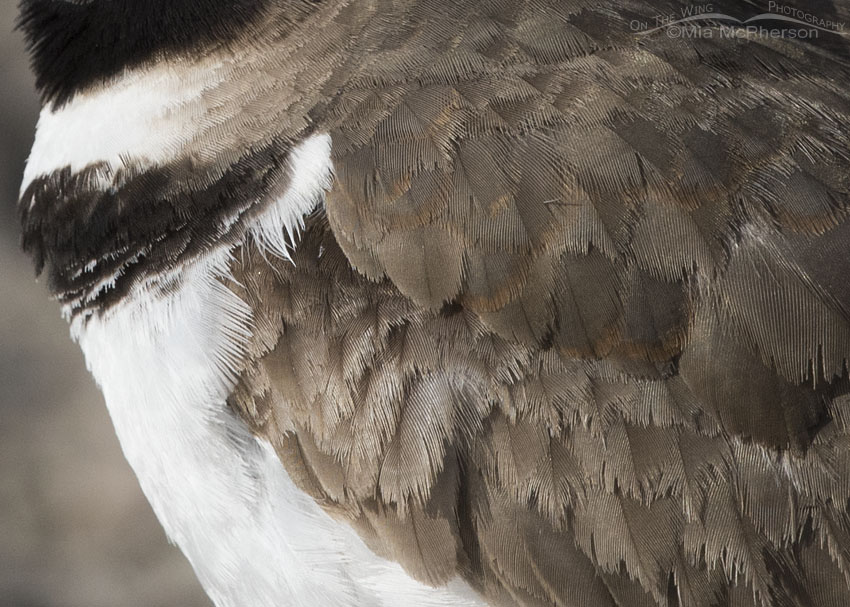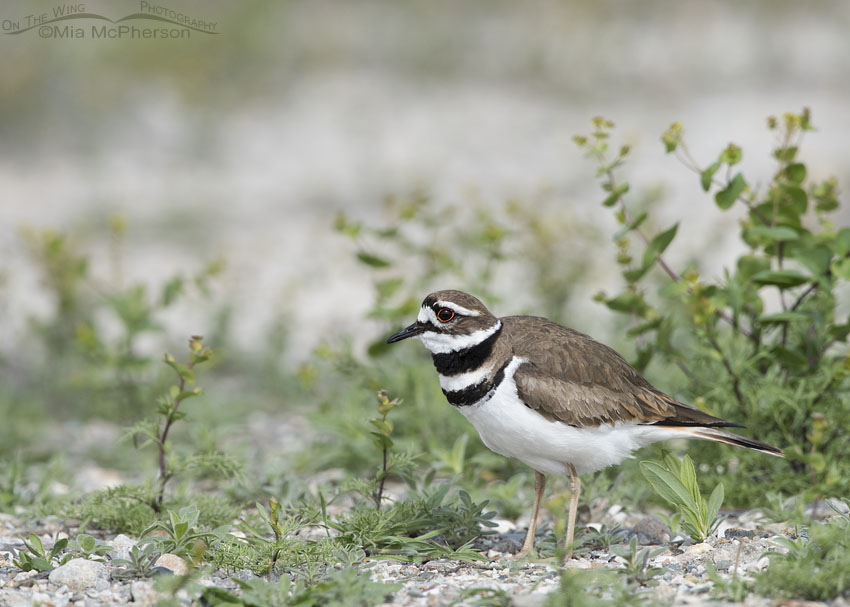 Adult Killdeer in breeding season – Nikon D810, f9, 1/1000, ISO 400, -0.3 EV, Nikkor 500mm VR with 1.4x TC, natural light
Adult Killdeer in breeding season – Nikon D810, f9, 1/1000, ISO 400, -0.3 EV, Nikkor 500mm VR with 1.4x TC, natural light
It is breeding season for Killdeer at Bear River MBR and for all of Utah. Killdeer are noisy all year long but to my ears they seem even noisier during the breeding season whether they are in flight or on the ground. Their scientific name is Charadrius vociferus and the second part of it is from the word vociferous:
adjective
1. crying out noisily; clamorous.
Killdeer are quite vociferous and it is easy to understand why they have that second part of their scientific name after listening to them call all morning!
Listen to a sound clip by Ted Floyd.
 Killdeer plumage detail – Nikon D810, f9, 1/1600, ISO 400, -0.3 EV, Nikkor 500mm VR with 1.4x TC, natural light
Killdeer plumage detail – Nikon D810, f9, 1/1600, ISO 400, -0.3 EV, Nikkor 500mm VR with 1.4x TC, natural light
I had the opportunity to take a series of close up images of one Killdeer two days ago while at the refuge and I thought would share a photo that shows the plumage details of the bird. I was a bit surprised by how worn many of the covert feathers were.
 Roadside Killdeer – Nikon D810, f7.1, 1/1000, ISO 400, +0.3 EV, Nikkor 500mm VR with 1.4x TC, natural light
Roadside Killdeer – Nikon D810, f7.1, 1/1000, ISO 400, +0.3 EV, Nikkor 500mm VR with 1.4x TC, natural light
Before I left the gate at the auto tour route I noticed that the staff at the refuge had put up a protective barrier in an area that contains lots of gravel and appears to be an overflow parking area where I have seen American Avocets and Killdeer nesting. My hat is off to the refuge staff for doing that and providing a safe area for the birds to nest in! I didn’t notice any birds on eggs in the protected section but it is probably just a matter of time before either the killdeer, stilts or avocets will be incubating in that area.
Bear River Migratory Bird Refuge is a great place to observe and photograph shorebirds nesting and seeing their chicks but care needs to be taken not to step on their eggs or the tiny chicks that will soon be running around.
I’m looking forward to seeing those little balls of fluff!
Life is good.
Mia
Click here to see more of my Killdeer photos plus facts and information about this species.
Ethics on photographing nesting birds:
- Do not approach too closely
- If the birds show any sign of distress, back away
- Don’t trim leaves, twigs or branches to get a clearer shot, you may inadvertently attract predators or cause the eggs/chicks to over heat
- Follow local, state and federal guidelines concerning nesting birds
- Don’t harass the birds to get an action shot
- Don’t stay a long time with nesting birds or chicks, that disrupts their normal behavior
- Always remember that your scent may draw predators to the area of nesting birds or birds with chicks.
For more information on the ethics of photographing nesting birds or chicks check out the Principles of Birding Ethics published by the American Birding Association.


Beautiful shots, Mia. Thanks for posting the ethics. Unfortunately, most of those that follow your blog don’t need to be reminded, it’s the rest of the numskulls out there!
How DO you get this kind of close-up of feathers??? Type of camera and lenses I imagine…
And thank you for the behavioral proto-rules – – all pretty new to a beginning birder! Never thought about human scent, for instance… I have always wanted to see anything in nature close-up – same with art…how do these things really get to look like they do??
The feather wear could be due to feather mites.
Beautiful photos, Mia. Grew up watching plenty of these birds in the Panhandle of Texas.
Wonderful post. Gorgeous photos of a stunning bird. And thanks for the reminder tips!
I’d like to add something to that list of things to NOT DO DURING BREEDING AND NESTING and that is Do not play tecordings of, make or use any kind of bird calls during these times.